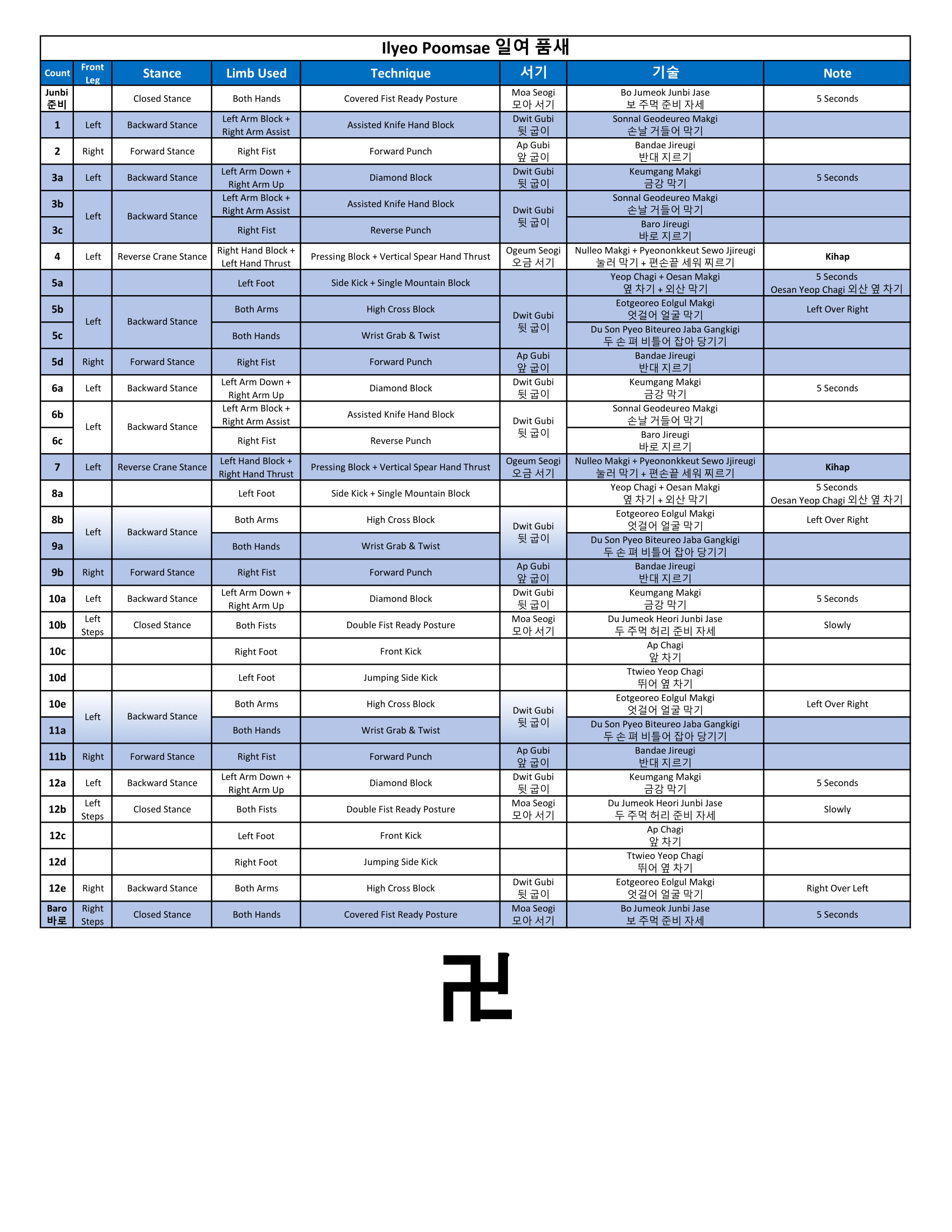Ilyeo
일여
“Eel-Yuh”
Yeon-Mu Line: 卍
Meaning: Oneness
9th Dan Poomsae
卍
Please note that the left facing sauwastika 卍 is NOT associated with the evils of the Nazi party of World War II nor is it associated with any sort of deplorable neo-Nazi movement.
The oldest archaeological evidence of the symbol in Asia is dated at around 3,000 BCE.
Ilyeo’s floor line references the Buddhist symbol which stands for the whole of creation.
Please follow this link to read more on the subject:
https://en.wikipedia.org/wiki/Swastika
“Ilyeo” is a state of spiritual cultivation in Buddhism, which means “oneness”, or the essence of thoughts of Venerable 원효 Wonyo from the Silla period of Korea. In Ilyeo, the dots, lines, and circles are unified. All techniques and moves are learned and performed differently. They are ultimately united with the mind and body to complete the practice of Taekwondo. Ilyeo Poomsae is based on this fundamental principle of martial arts.
At this stage of practice, the practitioner learns how all movements occur and conclude in a state of detachment, beyond the artificial actions manifested through conscious thoughts.
“The ready posture is Covered Fist Ready Posture. It is Taekwondo’s last Poomsae. It assumes the Junbi posture wherein the left hand and right fist are lightly wrapped in front of the chin, signifying unity and moderation and the flow of energy throughout the body and hands without interruptions. Its Poomsae line 卍 represents Ilyeo’s thoughts, representing the state of self-effacement in Bon (main body), Che (body) and Youg (use).
In the practice stage, you will learn how the movements occur and conclude in a state of detachment beyond the artificial actions manifested through conscious thoughts.
New movements in this Poomsae include 엇걸어 얼굴 막기 Eotgeoreo Eolgul Makgi (High Cross Block), 외산 막기 + 옆 차기 Oesan Makgi + Yeop Chagi (Single Mountain Block + Side Kick), 두 손 펴 비틀어 잡아 당기기 Du Son Pyeo Biteureo Jaba Gangkigi (Wrist Grab & Twist), 뛰어 옆 차기 Ttwieo Yeop Chagi (Jumping Side Kick) and 오금 서기 Ogeum Seogi (Reverse Crane Stance).”
Technique Summary
서기 Stances:
Closed Stance / Moa Seogi / 모아 서기
Backward Stance / Dwit Gubi / 뒷 굽이
Forward Stance / Ap Gubi / 앞 굽이
Reverse Crane Stance / Ogeum Seogi / 오금 서기
방어 기술 Defensive Skills:
Assisted Knife Hand Block / Sonnal Geodeureo Makgi / 손날 거들어 막기
Diamond Block / Keumgang Makgi / 금강 막기 (5 Seconds)
Palm Heel Pressing Block / Batangson Nulleo Makgi / 바탕손 눌러 막기
Single Mountain Block / Oesang Makgi / 외산 막기 (5 Seconds)
High Cross Block / Eotgeoreo Eolgul Makgi / 엇걸어 얼굴 막기
공격 기술 Offensive Skills:
Forward Punch / Bandae Jireugi / 반대 지르기
Reverse Punch / Baro Jireugi / 바로 지르기
Spear Hand Vertical Thrust / Pyeononkkeut Sewo Jjireugi / 편손끝 세워 찌르기
Side Kick / Yeop Chagi / 옆 차기 (5 Seconds)
Front Kick / Ap Chagi / 앞 차기
Jumping Side Kick / Ttwieo Yeop Chagi / 뛰어 옆 차기
특수품 Special Skills:
Covered Fist Ready Posture / Bo Jumeok Junbi Jase / 보 주먹 준비 자세 (5 Seconds)
Wrist Grab & Twist / Du Son Pyeo Biteureo Jaba Gangkigi / 두 손 펴 비틀어 잡아 당기기
Double Fist Ready Posture / Du Jumeok Heori Junbi Jase / 두 주먹 허리 준비 자세
기합 Kihap:
On the first Pressing Block + Vertical Spear Hand Thrust
On the second Pressing Block + Vertical Spear Hand Thrust
Performance Notes:
Sport Poomsae:
This is the only Yudanja Poomsae which is not part of any age division’s competitive range.Footwork:
Every turn in this Poomsae is to the left except for the very last one which returns to Covered Fist Ready Posture.Rhythm / Tempo:
Be mindful of the different intervals between movements, which are determined by whether or not the next technique is offensive or defensive.Reverse Crane Stance:
This stance is identical to Crane Stance in all but the placement of the raised foot — press the instep of the foot into the back of your knee.Single Mountain Block + Side Kick:
The arm should be in Single Mountain Block’s 1st Position while you chamber your Side Kick, the block and kick should complete at the same time.High Cross Block:
The dominant side is determined by the leg which is landing forward.Wrist Grab & Twist:
Open your hands and turn them clockwise until the wrists have swapped positions before proceeding to 1st Position for Forward Stance + Forward Punch.Double Fist Ready Posture:
Pull the fists directly to the hips without any sort of preparatory motion. It should be done a little slower than usual but not drawn out to 5 seconds.Front Kick → Jumping Side Kick:
Keep your hands in Double Fist Ready Posture during the Front Kick, feel free to use your hands to help propel yourself into the air for the Jumping Side Kick at which point the arms should pull back to the body.


